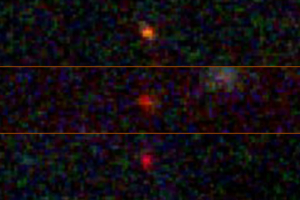Confirmation of the unusual objects could also solve a persistent enigma in physics.
Thanks to recent images of three objects originally thought to be galaxies captured by the new James Webb Space Telescope (JWST), a pair of Colgate researchers have found what could be the first confirmation of what are called dark stars, massive objects that were likely formed in the early stages of the universe.

Cosmin Ilie, assistant professor of physics and astronomy, and Jillian Paulin ’23, now a doctoral candidate in physics and astronomy at the University of Pennsylvania, along with Katherine Freese of the University of Texas at Austin, published their findings in the July 11 issue of the Proceedings of the National Academy of Sciences.
Contrary to their name, dark stars would have to be extremely bright — so bright that the trio of researchers suggest that the stars could be mistaken with something much larger. “One dark star can shine as bright as an entire galaxy. They’re about a million times the mass of the sun and a billion times as bright,” explains Paulin. “The radii of these objects are also insane, about 10 times the distance between earth and the sun.”
The “dark” label comes from what fuels the stars. Rather than being powered by fusion, like our sun and other stars in our galaxy, they’re powered by energy from the annihilation of dark matter. “Dark matter is what we call the missing mass in the universe that we can’t see, but which we have known is there since the 1920s,” Ilie explains.
Paulin says that only 0.1% of the mass of these dark stars would be dark matter, the rest would be a mix of hydrogen and helium. “It just so happens that dark matter annihilation is a much more efficient heating mechanism than fusion.”
Ilie and Freese had shown in 2012 that dark stars can grow to be supermassive. In addition, objects formed very early in the universe have high redshifts. Redshifts, like the lowering of the tone of a siren as it recedes, can be used to assess how distant an object is, and by inference, when a celestial object was formed. The high redshift in the objects in the JWST images, combined with their intensity, was puzzling at first, but also provided a clue. “Things need to cool down significantly in order for their structure to form. A galaxy would need to form a billion stars, which would take a long time,” explains Paulin. “But, you would have time to form one supermassive dark star.”
To resolve the conundrum, the team created a model of what a dark star would have to look like. “We found that the three objects we discussed in the paper were consistent with our model,” Paulin says.
The researchers are careful to emphasize that their study doesn’t confirm the existence of dark stars, but high-quality spectral data obtained in the future with the JWST could provide the smoking gun. Paulin says the initial results are promising. “If these do turn out to be dark stars, that’s further evidence that dark matter exists because these objects are inherently powered by dark matter. It will also give us more information about the nature of objects in the early universe.”
